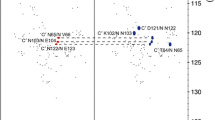Abstract
Ataxia is a genetic neurological disorder characterised by a neurodegenerative process affecting a motor cortex responsible for balance and coordination. Recently several genes that cause autosomal dominant ataxia development were identified. These abnormal genes share a common ability to produce abnormal ataxin proteins that can affect nerve cells in the cerebellum and spinal cord. Here, using the Resonant Recognition Model (RRM) based on signal processing, we analysed ataxin proteins and identified the characteristic features corresponding to their biological activities. The RRM is a physico-mathematical model developed for analysis of protein interactions. By incorporating Smoothed Pseudo Wigner–Ville distribution (SPWV) in the RRM, we can define the active regions along the protein molecule. The results showed that our computational predictions correspond closely with the experimentally identified locations of the active/binding sites for ataxin-1 and ataxin-3 protein groups. The results obtained provide a valuable insight into the functional performance of ataxin proteins.



Similar content being viewed by others
References
Bird TD (2005) MD Hereditary Ataxia Overview. GeneReviews
Boashash B (2005) Time-frequency signal analysis and processing. Prentice Hall PTR, Englewood Cliffs
Burnett B, Li F, Pittman RN (2003) The polyglutamine neurodegenerative protein ataxin-3 binds polyubiquitylated proteins and has ubiquitin protease activity. Hum Mol Genet 12(23):3195–3205
Chai Y, Koppenhafer SL, Shoesmitth SJ et al (1999) Evidence for proteasome involvement in polyglutamine disease: localization to nuclear inclusions in SCA3/MJD and suppression of polygutamine aggregation in vitro. Hum Mol Genet 8:673–682
Ciblis P, Cosic I (1997) The possibility of soliton/exciton transfer in proteins. J Theor Biol 184:331–338
Cosic I (1994) Macromolecular bioactivity: is it resonant interaction between macromolecules?—theory and applications. IEEE Trans Biomed Eng 41:1101–1114
Cosic I (1995) Virtual spectroscopy for fun and profit. Biotechnology 13:236–238
Cosic I (1997) The resonant recognition model of macromolecular activity. Birkhauser, Basel
Cosic I (2001) The Resonant Recognition Model of bio-molecular interactions: possibility of electromagnetic resonance. Pol J Med Phys Eng 7(1):73–87
Cosic I, Nesic D, Pavlovic M et al (1986) Enhancer binding proteins predicted by informational spectrum method. Biochem Biophys Res Commun 141(2):831–838
Cosic I, Drummond AE, Underwood JR et al (1994) A new approach to growth factor analogue design: modelling of FGF analogues. Mol Cell Biochem 130:1–9
Cummings CJ, Mancini MA, Antalffy B et al (1998) Chaperone suppression of aggregation and altered subcellular proteasome localization imply protein misfolding in SCA1. Nat Genet 19:148–154
Davidson JD, Riley B, Burright EN et al (2000) Identification and characterization of an ataxin-1-interacting protein: A1Up, an ubiquitin like nuclear protein. Hum Mol Genet 9(15):2305–2312
De Trad CH, Fang Q, Cosic I (2000) The Resonant Recognition Model (RRM) predicts amino acid residues in highly conservative Regions of the hormone prolactin (PRL). Biophys Chem 84(2):149–157
De Trad CH, Fang Q, Cosic I (2002) Protein sequences comparison based on the wavelet transform approach. Protein Eng 15(3):193–203
Gatchel JR, Zoghbi HY (2005) Diseases of unstable repeat expansion: mechanisms and common principles. Nat Rev Genet 6(10):743–755
Huynh DP, Yang HT, Vakharia H (2003) Expansion of the poly Q repeat in ataxin-2 alters its Golgi localization, disrupts the Golgi complex and causes cell death. Hum Mol Genet 12:1485–1496
Helmlinger D, Hardy S, Sasorith S et al (2004) Ataxin-7 is a subunit of GCN5 histone acetyltransferase-containing complexes. Hum Mol Genet 3(12):1257–1265
Irwin S, Vandelft M, Pinchev D et al (2005) RNA association and nucleocytoplasmic shuttling by ataxin-1. J Cell Sci 118:233–242
Kaytor MD, Byam CE, Tousey SK et al (2005) A cell-based screen for modulators of ataxin-1 phosphorylation. Hum Mol Genet 14(8):1095–1105
Klegeris A, Giasson BI, Zhang H et al (2006) Alpha-synuclein and its disease-causing mutants induce ICAM-1 and IL-6 in human astrocytes and astrocytoma cells. FASEB J 20(12):2000–2008
Koyano S, Iwabuchi K, Yagishita S et al (2002) Paradoxical absence of nuclear inclusion in cerebellar Purkinje cells of hereditary ataxias linked to CAG expansion. J Neurol Neurosurg Psychiatry 73:450–452
Lalovic D, Davidovic DM, Bijedic N (2003) Quantum mechanics in terms of non negative smoothed Wigner functions. Phys Rev A 46:1206–1212
Li F, Macfarlan T, Pittman RN et al (2002) Ataxin-3 is a histone binding protein with two independent transcriptional corepressor activities. Biol Chem 277(47):45004–45012
Lin X, Antalffy B, Kang D, Orr HT, Zoghbi HY (2000) Polyglutamine expansion downregulates specific neuronal genes before pathologic changes in SCA1. Nat Neurosci 3:157–163
Lunkes A, Mandel JL (1997) Polyglutamines, nuclear inclusions and neurodegeneration. Nat Med 3:1201–1202
Mao Y, Senic-Matuglia F, Di Fiore PP et al (2005) Deubiquitinating function of ataxin-3: insights from the solution structure of the Josephin domain. PNAS 36:12700–12705
Piedras-Renterıa ES, Watase K, Harata N et al (2001) Increased expression of α1A Ca2+ channel currents arising from expanded trinucleotide repeats in spinocerebellar ataxia type 6. J Neurosci 21(23):9185–9193
Pirogova E, Fang Q, Akay M et al (2002) Investigation of the structure and function relationships of oncogene proteins. Proc IEEE 90(12):1859–1867
Pirogova E, Simon GP, Cosic I (2003) Investigation of the applicability of dielectric relaxation properties of amino acid solutions within the Resonant Recognition Model. IEEE Trans Nanobiosci 2(2):63–69
Schols L, Bauer P, Schmidt T et al (2004) Autosomal dominant cerebellar ataxias: clinical features, genetics, and pathogenesis. Lancet Neurol 3:291–304
Shibata H, Huynh DP, Pulst SM (2000) A novel protein with RNA-binding motifs interacts with ataxin-2. Hum Mol Genet 9:1303–1313
Tsai C-C, Kao HY, Mitzutani A et al (2004) Ataxin 1, a SCA1 neurodegenerative disorder protein, is functionally linked to the silencing mediator of retinoid and thyroid hormone receptors. PNAS 101(12):4047–4052
Tsuda H, Jafar-Nejad H, Patel AJ et al (2005) The AXH domain of ataxin-1 mediates neurodegeneration through its interaction with Gfi-1/Senseless proteins. Cell 122(4):633–644
Veljkovic V, Slavic M (1972) General model of pseudopotentials. Phys Rev Lett 29:105–107
Wigner EP (1932) On the quantum correction for thermodynamic equilibrium. Phys Rev 40:749
Author information
Authors and Affiliations
Corresponding author
Rights and permissions
About this article
Cite this article
Pirogova, E., Vojisavljevic, V., Hernández Cáceres, J.L. et al. Ataxin active site determination using spectral distribution of electron ion interaction potentials of amino acids. Med Biol Eng Comput 48, 303–309 (2010). https://doi.org/10.1007/s11517-010-0587-0
Received:
Accepted:
Published:
Issue Date:
DOI: https://doi.org/10.1007/s11517-010-0587-0




